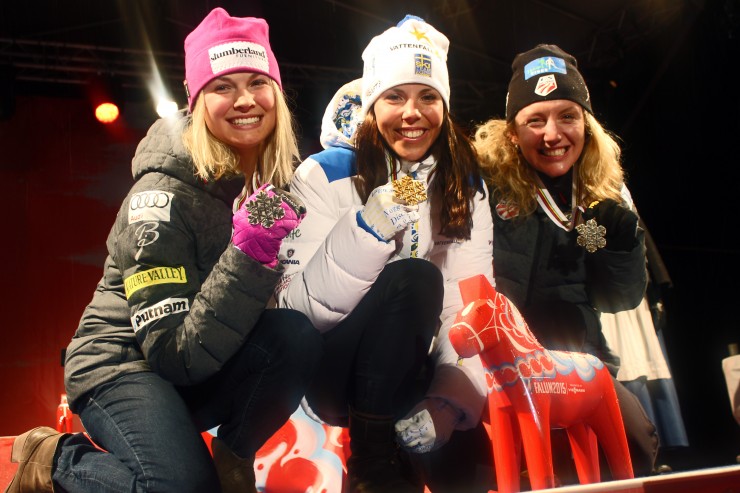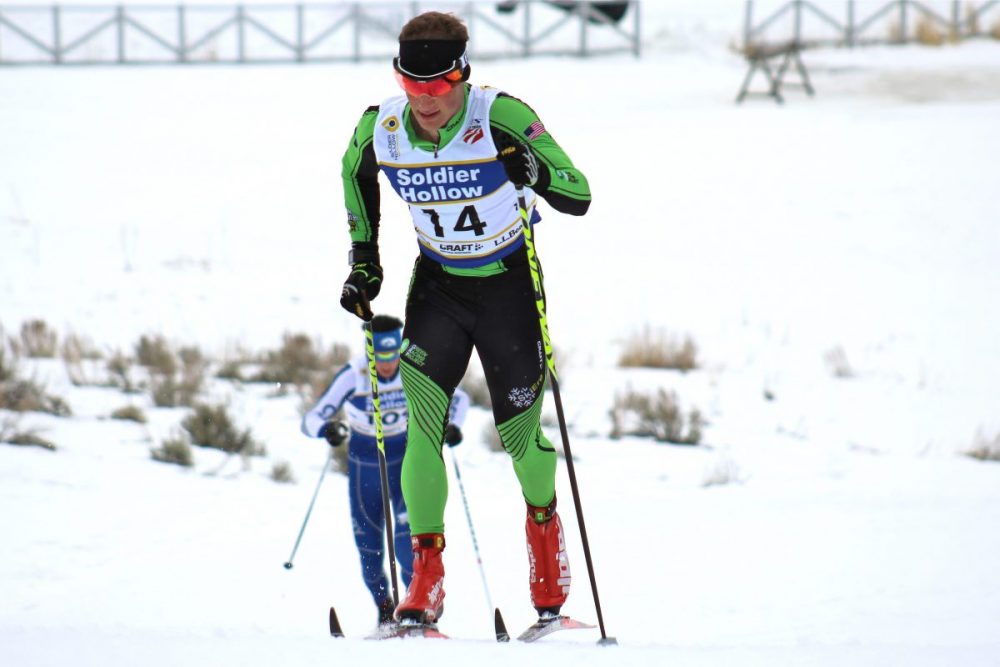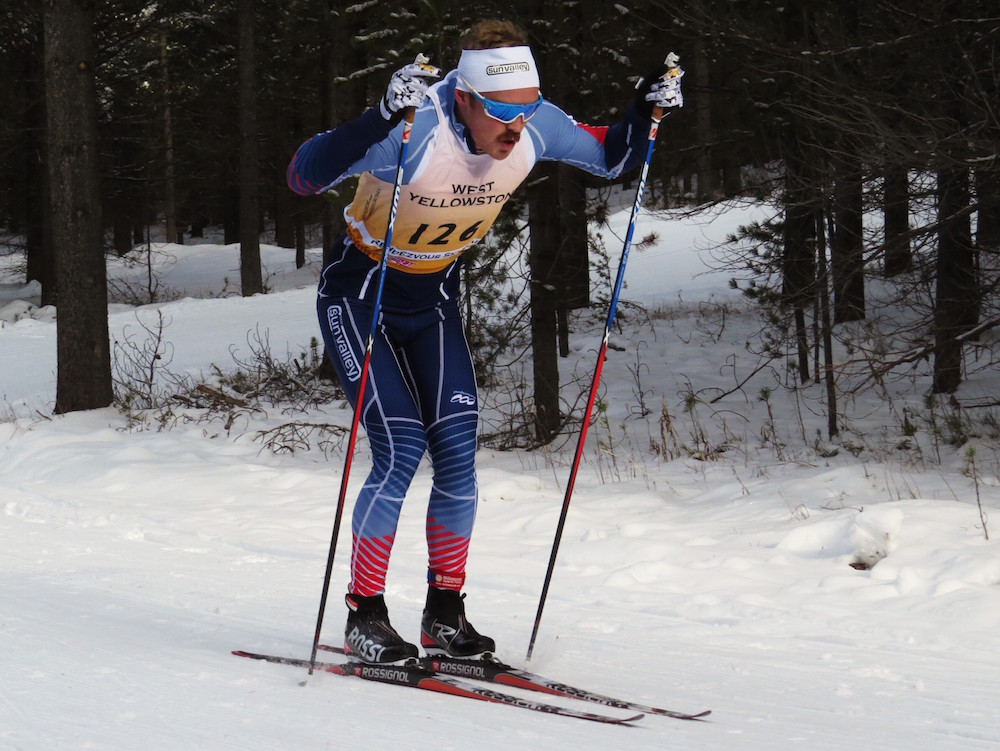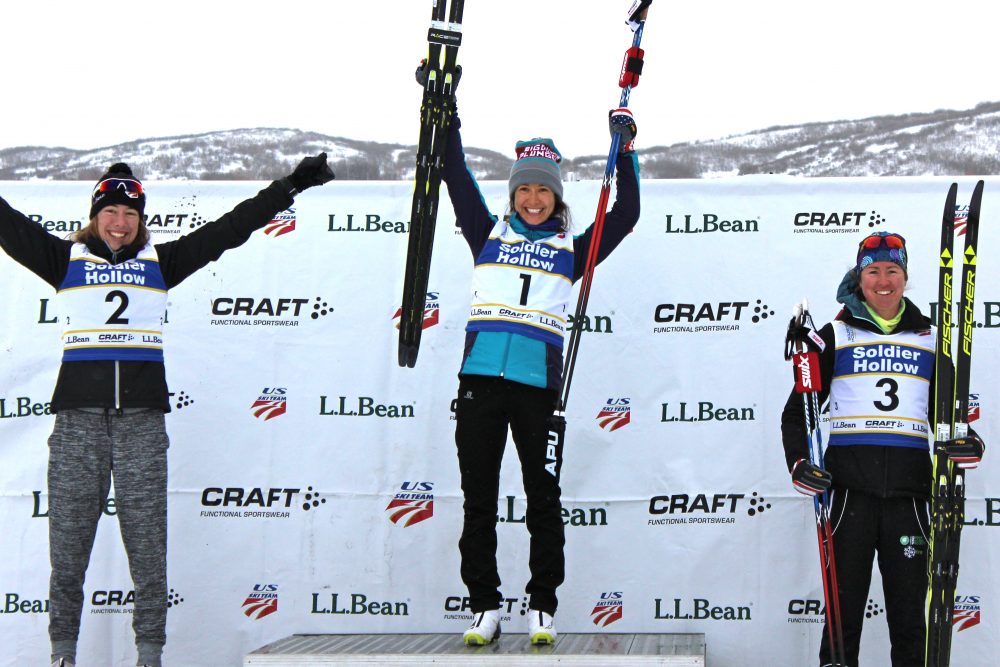
On Wednesday, the U.S. Ski and Snowboard Association (USSA) announced its team nominations for the International Ski Federation (FIS) 2017 Nordic World Ski Championships, scheduled for Feb. 22-March 5 in Lahti, Finland. Following the announcement, FasterSkier spoke with U.S. Ski Team Head Coach Chris Grover to discuss the reasoning behind some specific skiers who were or were not named to the team.
Applying the criteria
First, a quick review: FasterSkier has previously discussed the substance and the operation of the objective selection criteria based on World Cup performance. These objective criteria placed the following members of the U.S. Ski Team (USST) onto the Lahti team based on their performance during the 2016/2017 World Cup season: Sadie Bjornsen, Rosie Brennan, Sophie Caldwell, Jessie Diggins, Simi Hamilton, Noah Hoffman, Andy Newell, Kikkan Randall, Ida Sargent, and Liz Stephen.
All 10 athletes were ranked in the top 50 of the sprint and/or distance standings that were released earlier this week. USST member Erik Bjornsen ranked slightly outside the top-50 cutoff for both disciplines (59th for sprint and 60th for distance), and so is technically a discretionary selection.
That leaves six additional athletes without USST status who were also selected through the exercise of discretion by the Selection Committee: Kyle Bratrud, Tad Elliott, Ben Lustgarten, and Cole Morgan for the men, and Caitlin Gregg and Chelsea Holmes for the women.

Lustgarten (70 points), Bratrud (63) and Elliott (56) are the top-three men in the distance ranking of the 2017 Championship Selection List. (The list takes an athlete’s best two finishes per discipline, including bonus points for U.S. nationals.) Morgan (70 points) is facially tied with Ben Saxton (also 70) on the men’s sprint list. (For more on why Morgan over Saxton, keep reading.)
Holmes (80 points) and Gregg (63) are top two on the women’s distance list, followed by Katharine Ogden (60) and Caitlin Patterson (52). The top-ranked domestic skier on the women’s sprint list, Kaitlynn Miller (60 points), was not selected for Lahti.
The principles of discretionary selection
This summer, USST Women’s Coach Matt Whitcomb told FasterSkier that making discretionary picks was one of the harder parts of his job, saying, “We love not to do it.” But, he added, “in any criteria, discretion can often be one of the most important pieces.”
Grover previewed how USST coaches might apply that discretion when he spoke with FasterSkier earlier this week, following the individual skate sprint in Toblach but before Wednesday’s announcement.
“We do pay very close attention to what is happening in those races [at U.S. nationals],” Grover said. “And we are following them live as best we can from over here. We’ve been paying very close attention, and we’ve had some discussions.”
Grover added that they had specifically been discussing “who we would start in which races in Lahti, because we absolutely want to fill every start spot, and we want to be able to have an alternate there in most cases as well, and that makes for some tough choices. Who’s skiing well domestically, who’s skiing well on the World Cup; it’s occasionally challenging to figure out which athletes are faster when they have the Atlantic Ocean between them.”
Grover mentioned at the time that he hoped to follow and apply the selection criteria fairly rigorously and systematically.

“The real key thing is that, at the bottom of the selection, we followed the selection criteria,” Grover said. “That’s key. Discretion really belongs to be used at the top, for those athletes who have a chance to come over and have big races at World Championships, and by big races I mean someone who can go on the podium, or the top five, top 10, or top 15. Look for some selections from USA, but I wouldn’t look for a lot of discretion at the end of the day. That doesn’t mean that we won’t use some, but we have a selection criteria, and we’ve created a clear path for athletes to visualize, and see how they are going to make it to the World Championships team, and we have to be very careful to honor those athletes, and their coaches, and their programs, and their hometowns, by selecting the athletes who came to the table, and raced fast, and won races. That’s the key for us.”
Grover seemed willing to temper the strict application of objective rankings with some more objective consideration of conditions on the ground, particularly following a U.S. nationals where some races featured rather variable weather.
“Of course we’re going to take everything into account,” Grover said, “take the waxing situation into account, tough waxing days. I know that some people struggled, I know that some teams struggled, that’s unfortunate. You absolutely want to see a national championship where it’s easy waxing, and then you get to see who is the best athlete out there. I’m also getting petitions from athletes who are like, ‘Yes, I felt sick during U.S. Nationals.’ And that’s tough too. You want to see everybody healthy, and having an easy wax day.”
“It’s occasionally challenging to figure out which athletes are faster when they have the Atlantic Ocean between them.” — Chris Grover, U.S. Ski Team head coach
But “at the end of the day,” Grover concluded, “we set up a selection criteria that was designed to give athletes a chance to have a bad race, to be sick for weekend, to give teams a chance to miss the wax, that’s why we only take the best two out of four distance races, and/or the best two out of four sprint races. That’s why the selection period is more than just U.S. nationals, but also includes the races from Yellowstone and Silver Star, so athletes have the chance to demonstrate their ability over a longer period of time, and to be able to throw out some bad races.”
FasterSkier previously discussed the theory that the bonus points given for podium finishes at U.S. nationals made solid performances there potentially decisive for an athlete’s selection.
Naming names
As Grover adumbrated earlier this week, the selection of the male skiers not currently on the USST was based directly on skiers’ standing on the Lahti points list. Those selections “are very straightforward,” Grover told FasterSkier on the phone on Thursday. “We went right off of the Lahti selection list.”
Grover added that they felt the need for only one more sprinter, in light of already having Hamilton, Newell and Erik Bjornsen on the team.

So why Morgan over Saxton for that one sprint spot, when both athletes had 70 points and were tied for first on the selection list? Tiebreakers.
“That had to go down to like a four-way tiebreak procedure in order to determine which athlete to select,” Grover recounted. “Because they both had a first place from SuperTour, they both had two second-place finishes, and so it was only by going to their fourth race, where Cole prevailed over Ben. So that was tough, and definitely as excited as we are for Cole, that was tough for Ben, to be in that situation.”
The tiebreaking race was “the skate qualifier only in Nationals.” Morgan finished 5.11 seconds and 17 places ahead of Saxton in Thursday’s demi-sprint, with Morgan clocking 3:20.23 and sixth vs. Saxton’s 3:25.34 and 23rd.
Turning to distance skiers, Grover said, “So then we had four sprinters that we wanted to start, and then we obviously needed some distance skiers. And we felt like with Erik Bjornsen and Noah Hoffman on the team, that if we went out and got three more additional distance skiers that we would have the depth that we needed to effectively fill start rights, plus have an alternate, in the distance races at Lahti, which is why we went and got the three guys. We just went right off the distance points list.”
That’s it for the men. As for the women, among American distance skiers, Gregg has a sterling championships résumé: bronze in the 10-kilometer freestyle at Falun in 2015. This performance, and Gregg’s ability to peak for it, figured heavily in the decision to go down to second on the women’s distance list and name Gregg, Grover noted.
“We definitely … view Caitlin as a really incredible distance skier,” Grover said, “somebody who has the ability, or at least has proven the ability in the past, to be able to target an event, train for an event, a certain event, prepare for it, and then ski quite well at that event. And of course I’m referencing the Falun 10-kilometer race from two years ago. We named her to the team as a potential starter for the women’s 30 k freestyle. And typically Caitlin has been somebody who’s great at the long-distance skating in particular, and gets stronger as the race gets longer. So we’re not guaranteeing start positions for any athletes right now, but Caitlin for sure will be a strong contender to race that last race for women at the World Championships.”
So Gregg was second on the distance list, but why not go down to Katharine Ogden (often referred to as “KO”) in third? In large part because of her youth – Ogden is still only 19 years old – and a concern for appropriate development.
“We absolutely agree that athletes should first aim to be successful at – in the age group that they’re competing against,” Grover said. “So for KO, that means World Juniors, and being successful at World Juniors. And that should be, in my opinion, the absolute focus of her year this year.”

He added that the strength of the current American women’s team made it questionable whether Ogden, despite her talent, would necessarily be stronger than any other option. The coaches would ask, “‘OK, yes, if we were to bring you to the [senior] World Championships, what are the actual events that we would start you in? Are you one of the best four women in the United States in those events?’ There most likely, at this particular moment, is not starting space for her. … She’s going to be an absolute talent for the future, but we also have one of the strongest, if not the strongest women’s team in the history of U.S. skiing. So it’s tough to break into that group when you’re limited to four starts.”
And what about Caitlin Patterson, an athlete who began the 2016/2017 season in Europe and scored World Cup points in the opening weekend, but never quite made the top 30 thereafter?
Patterson was “one that we talked about, for sure,” Grover said. “However, she was not even the next woman on the points list behind Caitlin Gregg. That was Katharine Ogden. … So any time you’re talking about using discretion and using it at the bottom of the list, and then jumping over athletes that are on the list to use that discretion, then it becomes quite complicated.”
Much as with Ogden, Grover noted that the strength of the current women’s team made it difficult to easily pencil Patterson in as a starter: “Our women’s team is so strong,” Grover said, “we didn’t necessarily see a race where we said, ‘You know what, Caitlin Patterson is within the top four women that we want to start in that particular event.’ It would have been a different situation if we didn’t have so many women making the objective criteria for World Cup in front of her.”
But Grover noted that Patterson was not necessarily off the team for good: “So it puts Caitlin Patterson in a really tough spot, and we definitely want to see her have more opportunities, and we are in fact trying to provide her more opportunities by actually offering her some World Cup starts in the next few weekends that she’s going to take advantage of. And we’ll see what happens. If she’s able to have some outstanding results, we may reconsider.”
As Grover alluded to regarding Patterson, the U.S. roster is not quite set in stone. “I think it’s important to recognize that we … may decide to add a man, or a woman, later to the World Championships Team,” Grover emphasized.
“We have not maxed out what our quotas are for that event by any means,” he continued “And if we see an outstanding result of some kind, either at World Cup or say U23s/World Juniors, we may choose to add somebody to the team, which we did … two years ago in Falun, when we added Ben Saxton after he’d been sixth in the sprint at the World Juniors. So nobody has guaranteed start rights at the Lahti World Championships. And it may be that our team grows slightly. Or it may stay the same; we just don’t know yet.”
End of an era?
And finally, a look back for a historical note before everyone looks forward to next month’s races in Lahti: Assuming that he is not added to the roster in the next few weeks, this will be the first American international championship team without Kris Freeman since 1997. Freeman, currently of Team Freebird but a USST member for 11 years before that, was named to a total of 15 championship teams from 1997 to 2015. He was at Falun in 2015, Sochi in 2014, Val di Fiemme in 2013, Oslo in 2011, Whistler in 2010, Liberec in 2009, Sapporo in 2007, Torino in 2006, Oberstdorf in 2005. He was at Val di Fiemme, for the first time, in 2003, Salt Lake City in 2002, Lahti in 2001, and before that, he was also at three FIS Junior World Championships: Štrbské Pleso, Slovakia, in 2000; Saalfelden, Austria, in 1999; and Pontresina, Switzerland, in 1998.

The last time Freeman was not named to an American championship team was Junior Worlds in Canmore in February 1997. To put that in perspective: top junior skiers at those races included Kristina Smigun, Axel Teichmann, Per Elofsson, and Lukas Bauer. American juniors racing at Canmore in 1997 included Rob Whitney, Pat Casey, and Lars Flora. Recent national champion Kevin Bolger (University of Utah) was 3 years old. Recent Nationals podium finisher Katharine Ogden was not born yet.
Freeman told FasterSkier a week ago at U.S. nationals that, even if he were not selected to his second Lahti team, he intended to keep competing for at least one more winter with an eye to Pyeongchang: “Still in it, I’ll be back next year and hopefully make the Olympic team.”
USST athlete Kikkan Randall keeps alive a streak going back to World Juniors at Štrbské Pleso in 2000. Counting 2017 in Lahti, she has been named to 16 championship teams (nine World Championships teams, four Winter Olympics teams, and three World Juniors teams) in that time.
And USST skier Andy Newell was named to his 14th championship team, continuing a streak that dates back to World Juniors at Szklarska Poręba in 2001.
Races in Lahti begin with the skate sprint on Feb. 23.
- 2017 Lahti World Championships
- 2017 World Championships
- ben lustgarten
- ben saxton
- Caitlin Gregg
- Caitlin Patterson
- Chelsea Holmes
- Chris Grover
- Cole Morgan
- Erik Bjornsen
- Ida Sargent
- Jessie Diggins
- Kaitlynn Miller
- katharine ogden
- Kyle Bratrud
- Liz Stephen
- Matt Whitcomb
- Noah Hoffman
- Rosie Brennan
- Sadie Bjornsen
- Simi Hamilton
- Sophie Caldwell
- Tad Elliott
- U.S. 2017 World Championships team
- U.S. Ski Team
Gavin Kentch
Gavin Kentch wrote for FasterSkier from 2016–2022. He has a cat named Marit.



